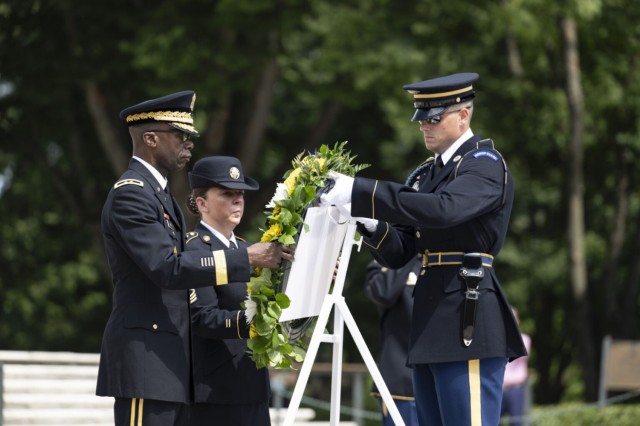WASHINGTON — The Army recently celebrated its 250th birthday — two and a half centuries of defending the nation since standing up, June 14, 1775. Not long after, on July 29, 1775, the Army Chaplain Corps was established to provide ministerial support to those Soldiers.

"The members of today's Army Chaplain Corps are sustaining and enriching a sacred legacy, which our predecessors began building even before our nation was founded in 1776," said Army Chaplain (Maj. Gen.) William Green Jr., the 26th Army chief of chaplains. "Gen. George Washington requested that chaplains be added to the Army to meet Soldiers' religious and spiritual needs, and to support good morals and morale."
At the request of Washington, the Continental Congress authorized one chaplain for each regular regiment of the Continental Army, Green said, adding that many of the militia regiments that served alongside those in the Continental Army also had chaplains.
Today, he said, the role of the Army Chaplain Corps remains as important as it was 250 years ago. The Chaplain Corps has evolved to include more than 3,000 chaplains, nearly 3,000 religious affairs specialists, more than 500 chaplain candidates and more than 50 directors of religious education across the regular Army, Army Reserve and Army National Guard. They continue to provide important religious support and advice on spiritual matters to Soldiers of all ranks.

VIEW ORIGINAL
"Our U.S. Army Chaplain Corps is the most multifaceted and capable chaplaincy in history, and we will remain so, to support our Army's preparations to win during multidomain and large-scale combat operations in the years ahead," Green said. "Our corps is a unique branch of the total Army that remains a necessary, critical contributor to our nation's success on the battlefields of the future, just as it was on the battlefields during our nation's war for independence."
Army Chaplain (Capt.) Bryce A. Wiltermood, a Protestant chaplain assigned to the 7th Special Forces Group at Eglin Air Force Base, Florida, didn't start out as an Army chaplain. Back in 2005, he enlisted in the Army as an indirect fire infantryman serving in the 75th Ranger Regiment and the 101st Airborne Division.
"It was a four-year enlistment," he said. "In those four years, I spent 18 months in combat zones as a mortarman. I went to Iraq ... multiple deployments, but a total of 18 months."

Following his initial enlistment, Wiltermood left the regular Army, transferred into the Army Reserve and completed a degree in psychology. But by that time, he said, he was thinking about donning the uniform again.
"I knew I wanted to continue serving, but I wanted to serve, I guess, in a different aspect," he said. "If I had to pinpoint it, it was from just really good chaplains that made a big impact on me. And so, after prayer and talking with my wife about it, this was a calling that I just pursued, kind of toward the end of getting my bachelor's degree ... [I] went from there and got my master's in divinity."
After completing his master's degree, Wiltermood reenlisted in 2016 as an Army chaplain. He is back on the front lines, this time without a weapon but instead ministering to the Soldiers who do the fighting.
"I've had a few more deployments," he said. "I went into combat zones in Iraq, Syria and Jordan. The chaplain is there to provide for this free exercise of religion for the troops, but also to advise commanders. Some key responsibilities or roles for chaplains include conducting religious support, spiritual or emotional care to the troops ... advisement is a big one, crisis response, casualty care, taking casualties, and just general resilience and readiness to ... Soldiers. [Through] spiritual fitness events or counseling or helping to prevent suicide ... the chaplain is a commander's tool to help ready the force."
The best chaplains seek out Soldiers, Wiltermood said; they don't wait for Soldiers to come to them.

"I think the chaplain should be out there and provide opportunities ... whether on a patrol or gate guard, the shooting range, or PT in the morning," he said. "Wherever Soldiers are, the chaplain should be there building relationships of trust."
Wiltermood said he plans to stay in the Army for as long as he can and continue to serve Soldiers wherever the Army sends him.
"I think ... after 20 years of Army service, I kind of see ... a little bit of myself in each [Soldier]," he said. "I think what everybody needs is ... a nonjudgmental, listening ear, someone who shows up, someone who's willing to listen and to just be a calming presence and a reminder of the holy."
While serving Soldiers, Wiltermood is helping troops stay strong and contributing toward the Army's spiritual support of Soldiers, which has been happening since before the United States became a country.
"One of the best things about this country is the ability for people to practice according to the dictates of their own conscience," he said. "And the chaplain, no matter what faith or nonfaith, is there to perform or provide."






Social Sharing